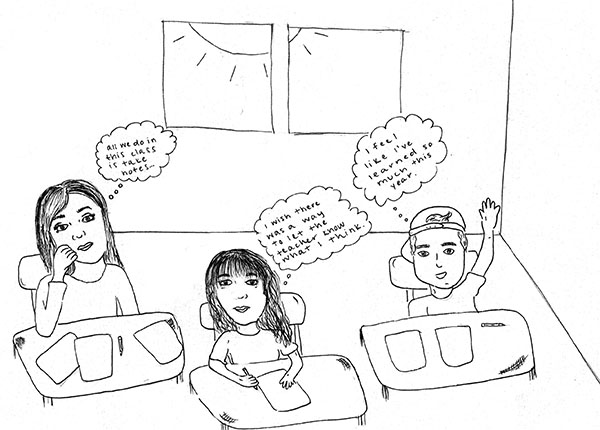Student surveys would improve class environment

Illustration by Raya Shoilekova
May 26, 2017
Helpless. In the collaborative, experimental classroom, communication is crucial, but without it, a student is helpless. Whether it be because of fear or stress, there are some students who simply cannot voice themselves, and it’s for this reason that they need a pressure-free outlet for concern.
In order to combat this, the Oracle Editorial Board proposes that each department adopts a teacher evaluation survey that allows for students to report to faculty at the end of each semester, separating them from possible classroom pressures. The Editorial Board recommends that the survey questions focus on how the student perceives the classroom, commenting on if they personally feel like the teacher compromises well or encourages honesty, for example.
The benefits to such a survey reside in the ability to further promote an environment that fosters growth and learning. By offering students the capability to honestly comment on a teacher, it provides an opportunity for the classroom to flourish. Not only does it give insight on how the teacher can improve, but it motivates students to be transparent and become more in tune with the classroom.
Surveys of a similar nature were implemented in the past, but ultimately, according to Matthew Whipple, Glenbrook Educators Association director, the administration decided that doing all the work to distribute and process uniform surveys was “not valuable,” especially because many teachers were already creating surveys for their students. While the old survey proposition had issues in distribution and analysis, the Editorial Board suggests that the surveys be digitally distributed through Google Forms, which provides both individual responses and charts to easily spot trends.
Whipple believes that gathering student input can be beneficial and, along with other teachers, distributes surveys to his students to get their feedback on his class. However, Whipple noted that students are not qualified to formally assess the teaching quality of the faculty; therefore, the surveys proposed by the Editorial Board would not be used as part of the formal evaluation process. Rather, it would be used as a form of teacher suggestion to help better classrooms.
Students in a class should take a digital survey each semester, filling out questions about the classroom environment rather than the quality of instruction or the class itself.
From there, the students should submit the digital surveys to the department, where the instructor’s colleagues could review the answers, not knowing who they’re reviewing to avoid bias. If a coworker analyzing the results finds an opportunity for growth, they can propose remedies and the results and feedback could be returned to the teacher through the Instructional Supervisor to ensure anonymity.
The surveys are more viable than ever in South’s current educational environment because of the increasing number of tools available to address classroom issues. Teachers have bountiful resources that their colleagues can recommend based on survey results: specific seminars, instructional books or teaching coaches to observe a class, providing a new lens to the dynamics of the classroom or lesson.
While the distribution and interpretation would be a seemingly formal process, the actions following should be anything but. The Oracle Editorial Board urges that this not interfere with the current, formal evaluation process of teachers. Understandably, the process would require time and effort, but in order to create an even closer bond between student and teacher, this is a crucial venture.
The current efforts being made are valiant steps toward improving the classroom environment, and informal surveys currently in place should continue, but an additional, more structured method of review may provide different, significant insight.
There is merit to the voices of the students, and it is exigent that there is a way to honestly express classroom needs. The results should be used to create a more cohesive learning environment for all students.




